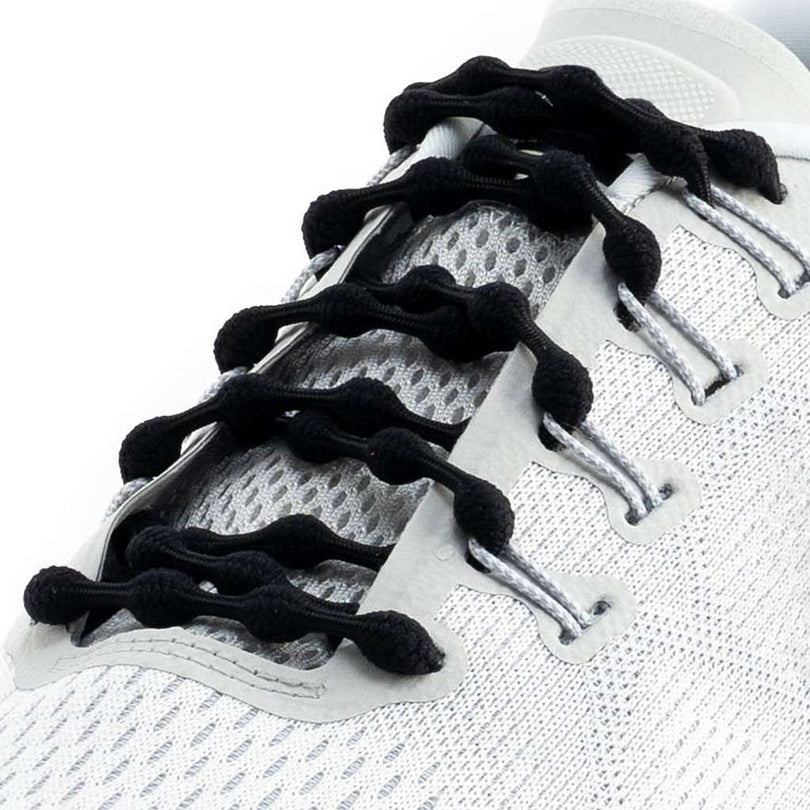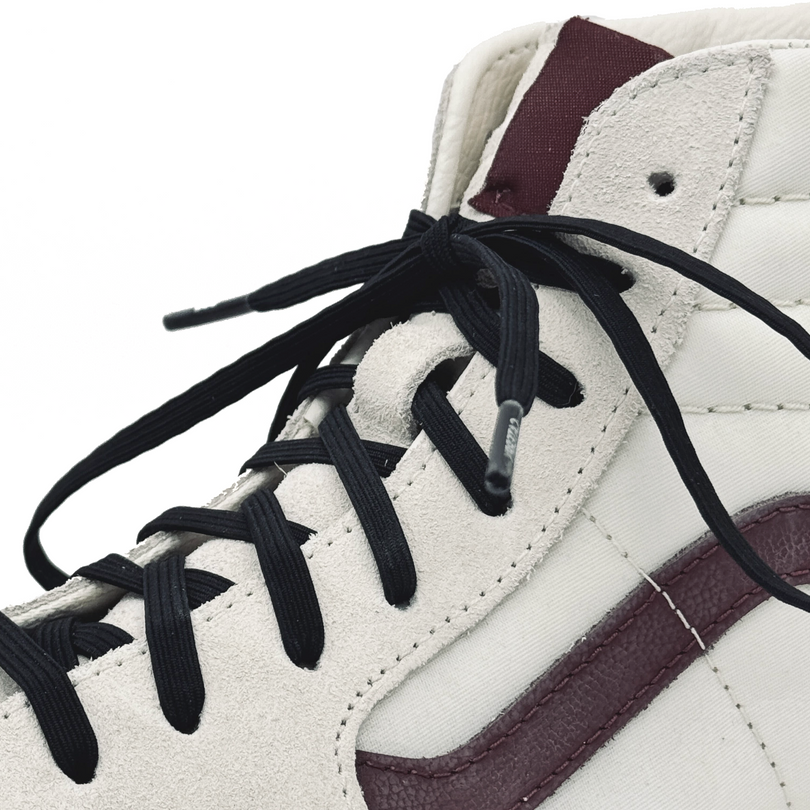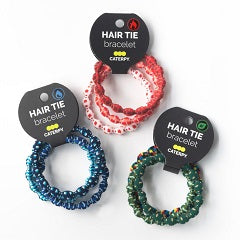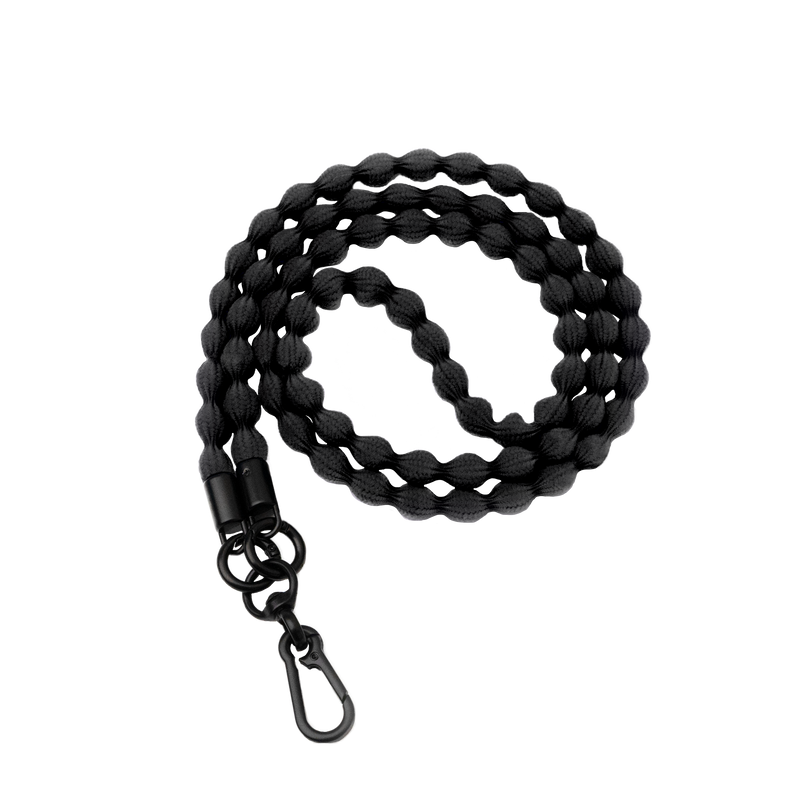Why Shoelaces Come Untied: Key Insights
Researchers at UC Berkeley discovered that shoelaces come untied due to a combination of stomping forces and the inertia of swinging legs. The repeated impact of a foot hitting the ground loosens the knot, while the whipping motion of laces pulls the knot apart. The phenomenon is consistent across different lace types, highlighting the mechanical vulnerabilities in traditional knots. This underscores the importance of secure, innovative lacing solutions, like Caterpy's no-tie elastic laces, which address these issues by providing a more reliable and convenient alternative.
A new study by mechanical engineers at UC Berkeley finally shows why your shoelaces may keep coming untied. It’s a question that everyone asks, often after stopping to retie their shoes, yet one that nobody had investigated until now. The answer, the study suggests, is that a double whammy of stomping and whipping forces acts like an invisible hand, loosening the knot and then tugging on the free ends of your laces until the whole thing unravels.
The study is more than an example of science answering a seemingly obvious question. A better understanding of knot mechanics is needed for sharper insight into how knotted structures fail under a variety of forces. Using a slow-motion camera and a series of experiments, the study shows that shoelace knot failure happens in a matter of seconds, triggered by a complex interaction of forces.
“When you talk about knotted structures, if you can start to understand the shoelace, then you can apply it to other things, like DNA or microstructures, that fail under dynamic forces,” said Christopher Daily-Diamond, study co-author and a graduate student at Berkeley. “This is the first step toward understanding why certain knots are better than others, which no one has really done.”
The study was published April 11 in the journal Proceedings of the Royal Society A.
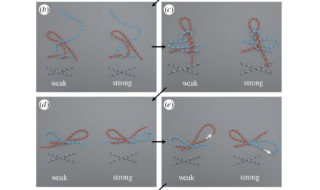
Click to enlarge: An overhead view of how to tie the weak knot (left) and the strong knot (right). The two knots only differ in the relative tying of the second trefoil to the first trefoil (panels b and c). After the loops are pulled out (indicated by the white arrows), the weak and strong knots become the prototypical false and square knots.
There are two ways to tie the common shoelace bow tie knot, and one is stronger than the other, but no one knows why. The strong version of the knot is based on a square knot: two lace crossings of opposite handedness on top of each other. The weak version is based on a false knot; the two lace crossings have the same handedness, causing the knot to twist instead of lying flat when tightened. The current study shows that both versions fail in the same way, and lays the groundwork for future investigation into why the two similar structures have different structural integrities.
“We are trying to understand knots from a mechanics perspective, such as why you can take two strands and connect them in a certain way that can be very strong, but another way of connecting them is very weak,” said Oliver O’Reilly, a Berkeley professor of mechanical engineering, whose lab conducted the research. “We were able to show that the weak knot will always fail and the strong knot will fail at a certain time scale, but we still do not understand why there’s a fundamental mechanical difference between those two knots.”
The goal of the new study was to develop a baseline understanding of the mechanics of how a shoelace bow tie knot comes untied under dynamic forces. Previous studies have described how knotted structures fail under sustained loads, but little research has shown how knotted structures fail under the dynamic pressures of changing forces and loads.
The first step was to record the process of a shoelace knot untying in slow motion. Study co-author and graduate student Christine Gregg, a runner, laced up a pair of running shoes and ran on a treadmill while her colleagues filmed her shoes.
The researchers found that a shoelace knot unties like this: When running, your foot strikes the ground at seven times the force of gravity. The knot stretches and then relaxes in response to that force. As the knot loosens, the swinging leg applies an inertial force on the free ends of the laces, which rapidly leads to a failure of the knot in as few as two strides after inertia acts on the laces.
“To untie my knots, I pull on the free end of a bow tie and it comes undone. The shoelace knot comes untied due to the same sort of motion,” said Gregg, a Berkeley Chancellor’s Fellow. “The forces that cause this are not from a person pulling on the free end, but from the inertial forces of the leg swinging back and forth while the knot is loosened from the shoe repeatedly striking the ground.”
In addition to the dynamic interaction of forces on the knot, the footage also revealed a large magnitude of acceleration at the base of the knot. To dig deeper, the researchers then used an impacting pendulum to swing a shoelace knot and test knot mechanics using a variety of different laces.
“Some laces might be better than others for tying knots, but the fundamental mechanics causing them to fail is the same, we believe,” Gregg said.
The researchers also tested their theory that increasing inertial forces on the free ends would trigger runaway failure of the knot. They added weights to the free ends of the laces on a swinging knot and saw that knots failed at higher rates as the inertial forces on the free ends increased.
“You really need both the impulsive force at the base of the knot and you need the pulling forces of the free ends and the loops,” Daily-Diamond said. “You can’t seem to get knot failure without both.”
Of course, when a person goes walking or running, their shoelaces don’t always come untied. Tightly tied laces can require more cycles of impact and leg swinging to cause knot failure than one might experience in a day’s worth of walking or running. More research is needed to tease apart all the variables involved in the process. But the study does offer an answer to the annoying question of why your laces seem fine one minute and then come untied the next.
“The interesting thing about this mechanism is that your laces can be fine for a really long time, and it’s not until you get one little bit of motion to cause loosening that starts this avalanche effect leading to knot failure,” Gregg said.
------------------------------------------------------------------------------------------------------------
ABOUT HEEL LOCK AND CATERPY:
Understanding the Heel-Lock Lacing Method
The heel-lock lacing method, also known as the "runner's loop" or "lace-lock," is a technique used to secure the heel in a shoe, reducing slippage and providing a snug fit, particularly during activities like running or hiking. The method involves using the extra eyelets at the top of the shoe to create a loop, through which the laces are threaded and then pulled tight. This locks the heel in place, preventing it from moving up and down within the shoe, which can lead to blisters, discomfort, or reduced stability.
How It Works:
- Extra Eyelets: Many athletic shoes have a pair of extra eyelets near the top. The heel-lock method makes use of these eyelets to create a loop on each side of the shoe.
- Lace Threading: After lacing up the shoe normally, the laces are passed through these extra eyelets on the same side, forming a loop.
- Crossing the Laces: The lace from each side is then crossed and threaded through the loop on the opposite side before being tied as usual.
- Tightening: When the laces are tightened, the loops pull against each other, creating a secure hold around the heel.
This method is particularly favored by runners and hikers who need to ensure their foot stays in place during vigorous activities, preventing the foot from slipping forward and causing discomfort.
Why Caterpy Elastic No-Tie Shoelaces Make the Heel-Lock Method Unnecessary
While the heel-lock method is effective with traditional shoelaces, Caterpy Elastic No-Tie Shoelaces offer an innovative alternative that renders this technique largely unnecessary. Here’s why:
-
Elasticity for a Snug Fit:
- Adaptive Fit: Caterpy laces are made from an elastic material that stretches and conforms to the shape of your foot. This elasticity provides a consistent tension across the entire length of the lace, automatically adjusting to the contours of your foot. As a result, the laces can hold the heel securely in place without the need for additional locking mechanisms.
- Dynamic Adjustment: Unlike traditional laces that can loosen over time, Caterpy laces maintain their tension, ensuring a snug fit throughout the day. The laces expand and contract with the natural movement of your foot, offering both comfort and security without the risk of slippage.
-
Avoiding Pressure Points:
- Even Pressure Distribution: One of the downsides of the heel-lock method with traditional laces is that it can create pressure points, especially over the top of the foot where the laces cross. This can lead to discomfort, particularly during extended wear. Caterpy laces distribute pressure evenly across the foot, eliminating these potential hotspots while still providing a secure fit.
- No Double Cross: Traditional heel-lock methods require the laces to cross over the top of the foot twice in the same location, which can restrict blood flow and cause discomfort. With Caterpy laces, you can achieve a similar level of heel security without the need for these tight, restrictive crossings.
-
Simplicity and Convenience:
- No-Tie Design: The no-tie design of Caterpy laces eliminates the need for complex lacing techniques altogether. Once you’ve laced up your shoes with Caterpy laces, you simply adjust them to your desired tension and go. This not only saves time but also ensures that your laces won’t come undone or loosen unexpectedly.
- Consistent Fit: Because Caterpy laces don’t rely on knots to stay secure, you don’t have to worry about your laces loosening during a run or hike. The elastic material keeps the laces at a consistent tension, providing reliable support for your heel without the need for adjustments.
-
Versatility Across Activities:
- All-Purpose Use: Whether you’re running, hiking, or just going about your daily activities, Caterpy laces provide the versatility to handle a wide range of demands. Their ability to maintain a snug fit makes them ideal for both high-intensity workouts and casual wear.
- Customizable Fit: Caterpy laces allow for customization in how tight or loose you want your shoes to feel, without the need for specific lacing techniques like the heel-lock. This makes them adaptable to different types of footwear and personal preferences.
Conclusion
The heel-lock lacing method is a well-established technique for securing the heel in traditional shoes, particularly for athletes who need stability and support. However, with Caterpy Elastic No-Tie Shoelaces, the benefits of a secure heel fit are achieved without the need for this method. The elasticity of Caterpy laces offers a snug, comfortable, and consistent fit, adapting to the natural movement of your foot while eliminating the need for tying and re-tying. This innovation not only simplifies the process of getting the perfect fit but also enhances comfort and convenience, making Caterpy laces an excellent choice for anyone seeking both performance and ease of use in their footwear.

